
Iwaishima island
Iwaishima ["Celebration"] island, circumference 12km, is
situated at the southern extreme of
Kaminoseki town, Yamaguchi prefecture. From Yanai city, on Honshu, the Iwai boat sails to the
island three times a
day, taking sixty five minutes. In ancient times, the island was known as
a
key shipping landmark, worshipped by seafarers as embodying the spirit of
the deities who ensure
safe landings. In those days, the route linking
Iwaishima and Himejima island (present-day Oita
prefecture) was the shortest
crossing between Honshu and north-eastern Kyushu. As the last sight of
land
for those heading west, Iwaishima's position was even widely known in the
imperial capital, as
witnessed by the island's appearance in the ancient collection of Japanese poems, the Manyoshu.
家人は 帰り早来と祝島 斎ひ待つらむ 旅行くわれを
My family may
Wait for me to return
As quick as I can
From my trip, cleaning themselves
As clean as Iwai isle
草枕 旅行く人を 祝島 幾代経るまで 斎ひ来にけむ
Praying for safety
Of people travelling on,
Pillowing the grass,
How many generations
Has Iwai isle remained?
trans. Teruo Suga, The Man'yo-shu, Tokyo: Kanda Institute of Foreign Languages:
Kanda University of International Studies, 1991
The climate of the island is
mild; the landscape is blessed by the northern-flowing "black tides" of
the
Bungo channel, which ensure fertile soil and bountiful fishing. But in a region
already rich in
ancient history, Iwaishima is particularly famous for its
Prefectural Non-Tangible Cultural Asset:
the kammai [Dance of the Gods] festival.
祝島の由来
祝島は、山口県上関町南端にあり、周囲12Kmほどの島です。本州の柳井市から、定期船「いわい」が、1日3便、所用時間65分で運行しています。古くから、行き交う船の航行安全を守る、神霊の鎮まる島として、崇められて来ました。当時は、祝島から姫島を経由して、九州北東地域に至るこの航路が、本州との最短コースであり、西下する時、最後の中継地である祝島の位置づけは、都にも広く知られていて、万葉集に見ることが出来ます。 豊後水道を北上する、黒潮に洗われる祝島は、気候温暖で、豊かな山や海の幸に恵まれています。そして、古代からの故事来歴も多く、とりわけ、山口県指定の無形文化財「神舞」は有名です。
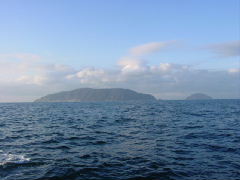 |
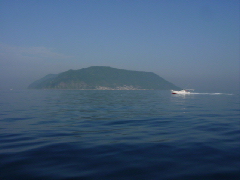 |
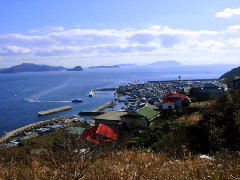 |
| 祝島遠景:北方から |
祝島遠景:東方から |
集落全景:西丘から |
Iwaishima from the north
|
Iwaishima from the east
|
The village from the west
|
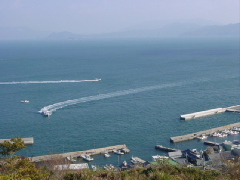 |
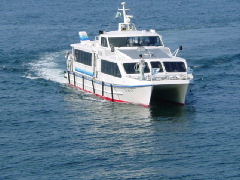 |
 |
| 集落:中丘から |
定期船「いわい」 |
傾斜地に建つ集落 |
The central port
|
The `Iwai` ferry
|
The village built on a slope
|
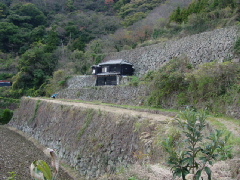 |
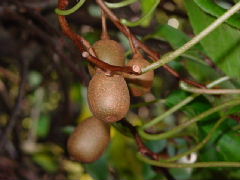 |
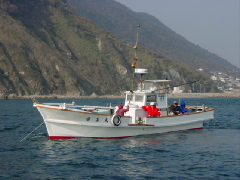 |
| 石垣:棚田では国内最大級 |
不老長生の秘果:コッコー |
遊漁船 |
The highly renowned stone−
walled terraced fields
|
The secret to a long life:
Iwaishima−style kiwis
|
A light fishing boat
|
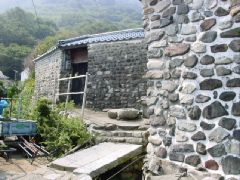 |
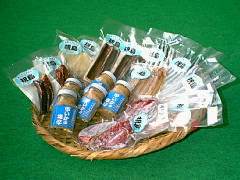 |
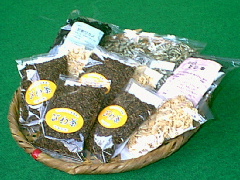 |
| 練塀 |
海の幸 |
山の幸 |
Stone and mortar walls
|
Fruits of the sea
|
Fruits of the mountains
|
Origins of the kammai festival
Legend has it that in the
year 886, a delegation from Imi village in Bungo province (northern
Kyushu)
was ordered by its feudal lord to worship at the Iwashimizu Hachiman shrine near
the
imperial capital, Heian (present-day Kyoto). On their way back to
Kyushu, they were caught in
a storm and anchored in Miura bay on Iwaishima. At that time, there were only three
households in the bay, and the islanders eked out a difficult living in
the harsh natural
environment. Nevertheless, they warmly received the Imi delegation, and
it is thought that
in gratitude, the Imi priests invoked the local deities and prayed for peace - as well as giving
the islanders the so-called precious five grains. Given this opportunity,
the islanders began
cultivating their land and worshipping the Kojin deity, celebrating the vast improvement in their
standard of living. In addition, they initiated the "Return
of the Grains" rites - an annual
pilgrimage to the Imi Betsugusha shrine (now held in August) - and further
decided once
every four years to welcome priests and sacred dance specialists from
Imi,
in order to hold joint ceremonies of thanks to the deities.
神舞の起源
伝承によれば、仁和2年(886)豊後國伊美郷の人達が、領主の命を受け、山城國の石清水八幡宮の神様を奉じて帰る途中、嵐に会い、祝島三浦湾に仮泊しました。当時の三浦地区には三軒の民家がありました。島民は厳しい自然環境の中、苦しい生活でしたが,一行を心からもてなしました。一行は、そのお礼として神様を祀って平安を祈願し、貴重な五穀の種を分与したといいます。それを機縁に荒神を敬い、大歳の神を祭り、農耕を始めたところ島民の生活は大きく向上しました。それから島民は「お種戻し」と称して、毎年八月(古くは三月)には、欠かさず豊後國伊美別宮社に参拝しました。そして四年毎に、大分県伊美別宮社から、20余名の神職里楽師を迎え、祝島を斎場に、神恩感謝の合同祭事を行うようになりました。
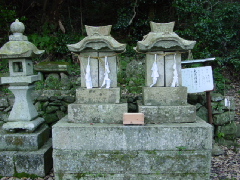 |
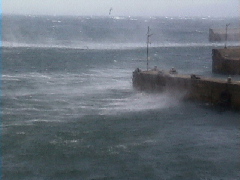 |
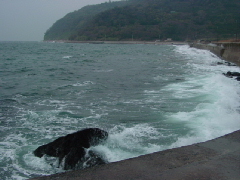 |
| 大歳御歳神 |
時折、突風が吹き荒れる |
大荒れの三浦湾 |
The kojin−sama shrines
|
Rough winds and seas
|
Heavy winds in Miura bay
|
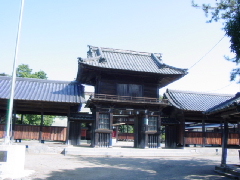 |
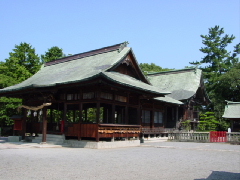 |
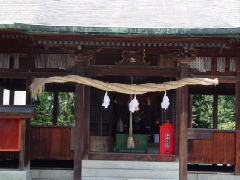 |
| 伊美別宮社・楼門 |
拝殿・幣殿 |
拝殿の正面 |
Imi Betsugusha shrine:
main gate
|
Imi Betsugusha:
main worship hall
|
Front view of the main
worship hall
|
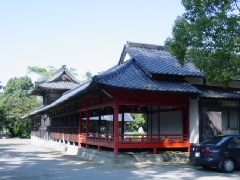 |
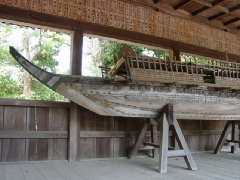 |
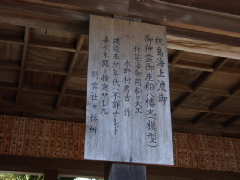 |
| 回廊 |
御座船:八幡丸 |
八幡丸の説明板 |
The shrine’s exterior walkway
|
The `Hachiman maru`, in
which the god crossed to
Iwaishima from Imi
|
History of the
`Hachiman maru`
|
The present-day kammai
During the kammai festival, ceremonial boats make the 49km crossing between Oita prefecture and
Yamaguchi prefecture. Like a scene from an ancient scroll, the kaidenma row-boats are particularly
gorgeous and eye-catching: richly decorated with fishermen's
pennants and flags, they take part in
the rites to welcome and send off the
priests from Imi. After the priests have landed, they process
to a thatched
shrine hall (newly constructed especially for the festival), where the
thirty-three
types of ancient kagura dances are performed over a five day period. In ancient times, these dances
are thought to have been offered to
the deities in Miura bay itself (now uninhabited), where even
today,
overlooking the bay on the slopes of Mount Kojin, two small shrines
remain.
神舞の次第
神舞神事は、大分県と山口県との海上49kmを、三隻の御座船が往復し、大漁旗で飾った櫂伝馬船や奉迎船がおりなす、「入船、出船神事」の海上絵巻は、まさに絢爛、勇壮そのものです。神様が上陸後、新調の苫で小屋掛けした仮神殿で、古式どおりに33種類の神楽舞が、5日間にわたって行われます。現在、三浦湾を見下ろす荒神山には二基の祠が祀ってありますが、古くはこの付近で神楽が奉納されたと伝えられています。
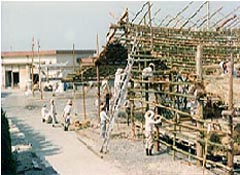 |
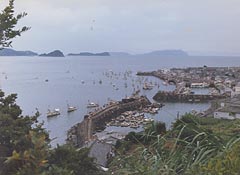 |
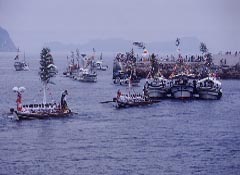 |
| 仮神殿組立 |
昭和51年 入船 |
平成8年 入船 |
Constructing the shrine hall
|
The priests and deities arrive
(1976 festival)
|
The kaidenma row−boats
(1996 festival)
|
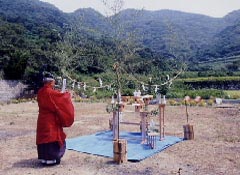 |
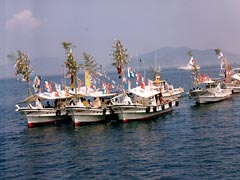 |
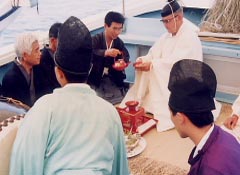 |
| 三浦荒神祭 |
御座船(神様船) |
酒迎えの儀(船上で) |
Rites at Mount Kojin
|
The priests’boats
|
Welcoming rites
|
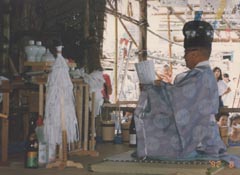 |
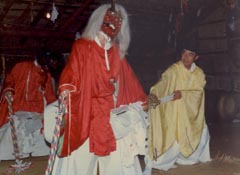 |
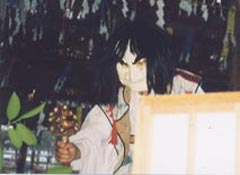 |
| 宮司祝詞 |
神主・荒神 |
白頭大神 |
Opening prayers
|
The entry of kojin−sama
|
Iwato Kagura dances
|
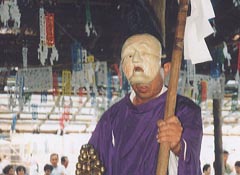 |
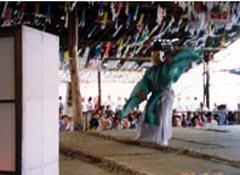 |
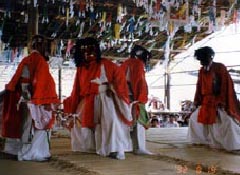 |
| 舞 鉾 |
八重垣 |
葉 鬼 |
Iwato Kagura (cont)
|
Iwato Kagura (cont)
|
Iwato Kagura (cont)
|
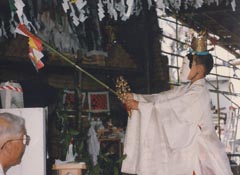 |
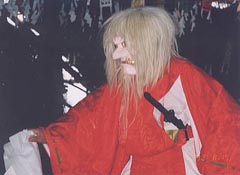 |
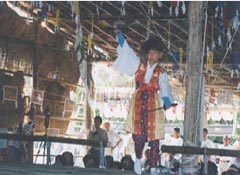 |
| 鈿女命 |
戸取明神 |
二 刀 |
Iwato Kagura (cont)
|
Iwato Kagura (cont)
|
Children’s Kagura
|
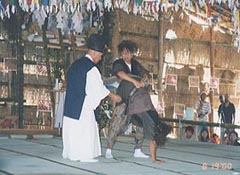 |
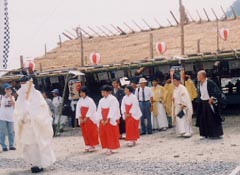 |
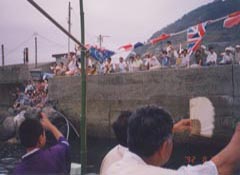 |
| 神角力 |
御還幸行列 |
出 船 |
Yodo Kaguro (cont)
|
Procession back to the port
|
The sending off
|
The next kammai festival will be held in August 2020
令和2年(2020)神舞
日程 8月16日〜19日の予定
( 編 修 2006・8・10 橋 部 好 明 )
|
| (英訳:橋部雄志) |





















